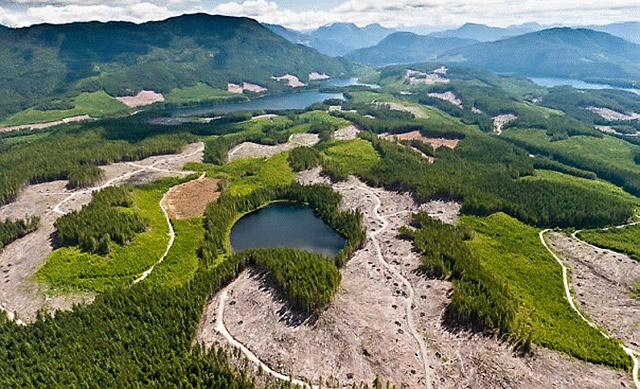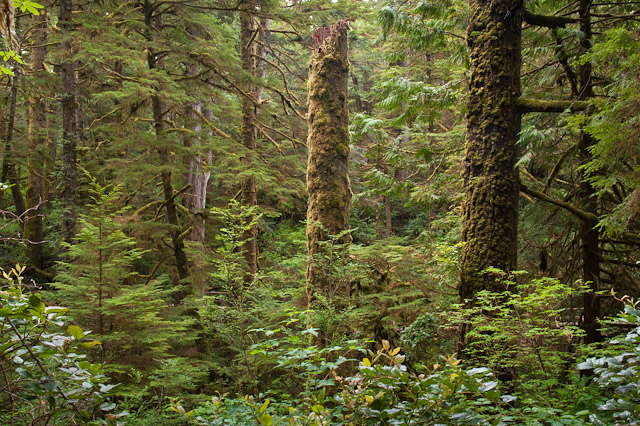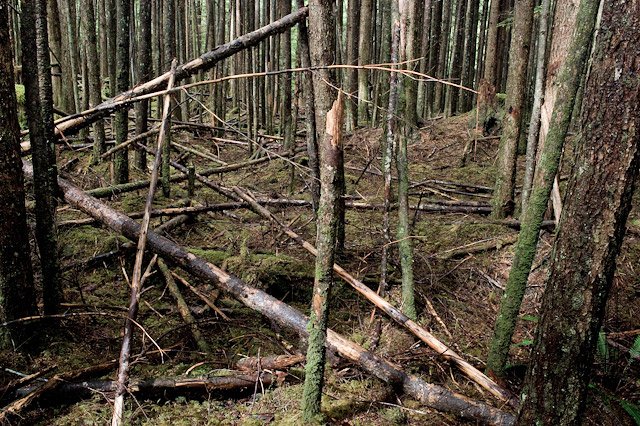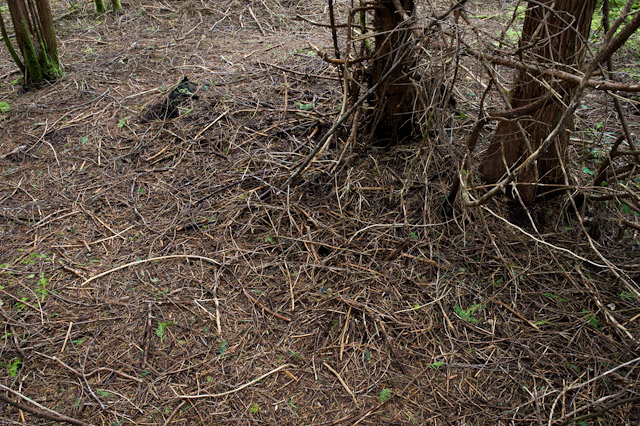|
| |
| 24. Juli 2011 |
Schockierende neue Bilder von Kahlschlägen im Great Bear Rainforest.
Das sogenannte „lighter touch logging“ – ein bloßer Etikettenschwindel |
| |
| Schockierende neue Bilder von brutalen Kahlschlägen im Great Bear Rainforest zeigen, wie wenig das von Greenpeace Canada, Sierra Club BC und ForestEthics so hoch gelobte Great Bear Rainforest-Abkommen vom 31.03.2009 wert ist und welchen unvorstellbaren Umweltzerstörungen diese drei Gruppen durch ihre Mitwirkung beim Aushandeln dieses Abkommens ihren Segen gegeben haben. „Celebration! Great Bear Rainforest protected“, posaunte Greenpeace Canada damals hinaus. „New ‚lighter touch’ logging regulations, based on Ecosystem-Based Management (EBM) is now a legal requirement“, hieß es in der Pressemitteilung. „Victory! Greenpeace feiert umfassenden Schutz des Great Bear Rainforest“ titelte Greenpeace Deutschland am 31.03.2009. „Great Bear Rainforest Success!“ lautete die Schlagzeile des Sierra Club BC. Als Meilenstein wurde damals die Einführung des EBM gefeiert, welches von der Provinzregierung als „low-impact logging regulations“ bezeichnet wurde (Ministry of Agriculture and Lands) und von den drei beteiligten Umweltschutzgruppen völlig verharmlosend und naiv-gutgläubig als „lighter touch logging“. Nach Ablauf einer Übergangsphase für die Forstindustrie sind die EBM- Holzeinschlagsregeln seit 1. Oktober 2009 im Gebiet des Great Bear Rainforest rechtsverbindlich. Viele Wissenschaftler und Forstwirtschaftskritiker hatten davor gewarnt, dass die EBM-Regeln keinerlei Schutz des Ökosystems beinhalten und der weiteren großflächigen und nachhaltigen Zerstörung des Great Bear Rainforest weiter Vorschub leisten werden. Als blanken Zynismus und Etikettenschwindel bezeichneten viele den von Greenpeace Canada, Sierra Club BC und ForestEthics benutzten Begriff „lighter touch logging“. |
| Zweifel am Erfolg ihres Verhandelns, einem wahren Pyrrhussieg und an dem, worauf sie sich bei ihrem Pakt mit der Forstindustrie und der Provinzregierung von BC eingelassen hatten, kamen den drei Umweltschutzgruppen spätestens bei der Vorlage ihres Berichtes „Slipping Through The Cracks? The Fate of Focal Species in the Great Bear Rainforest“ im März 2010. Die Hinhaltetaktik der Provinzregierung war aufgegangen, gegebene Versprechen wurden nicht eingelöst, zeitliche Zusagen nicht eingehalten. „The plan to protect large areas of the Great Bear Rainforest from logging has fallen so far behind schedule that key species could soon be put at risk“, schrieb Mark Hume damals in der Globe and Mail (Logging plans delay puts species at risk: study; 5. März 2010). Wie das vorab so hoch gepriesene lighter touch logging überhaupt von den Forstkonzernen im Wald umgesetzt wird und wie es konkret aussieht, wurde von den drei beteiligten Umweltschutzgruppen lange Zeit erst gar nicht überprüft. Den Forstkonzernen wurde freie Hand gelassen, eine Inspektion der Holzeinschlagsflächen fand nicht statt. Man vertraute ihnen blind und ließ sie gewähren. Vielleicht hatten die drei Umweltschutzgruppen bereits eine dumpfe Vorahnung, dass das, was sie tatsächlich im Wald vorfinden werden nicht dem entsprach, was sie sich an den Verhandlungstischen idealerweise zurechtgeträumt hatten. Vielleicht wollten sie nicht mit zerstörerischen neuen Kahlschlägen konfrontiert werden, die sie durch ihre Beteiligung am Aushandeln der EBM-Regeln mit zu verantworten haben. |
| |
Kahlschläge wie diese verkaufen Greenpeace, ForestEthics und Sierra Club BC
als „lighter touch logging“ – ein bewusst irreführender Etikettenschwindel |
 |
Gray Landscape Unit in TimberWest tenure, South Central Coast, Great Bear Rainforest, June 2011
© Garth Lenz, with aerial support by Lighthawk/ForestEthics, Greenpeace, Sierra Club BC. Backgrounder
for press release June 28, 2011. TimberWest logging threatens Great Bear Rainforest conservation model |
| |
| Erst jetzt hatten sie den Mut, vom Flugzeug aus zu betrachten, wie ihr gepriesenes und beworbenes lighter touch logging tatsächlich aussieht, vor allem in dem Gebiet, in welchem der Forstkonzern TimberWest wütet. „With TimberWest, what I saw was a very extended patchwork of clear-cuts, one after another“, sagte Jens Wieting vom Sierra Club BC. „It was very shocking to see.“ (Logging laggard threatens Great Bear Rainforest conservation, Tyler Harbottle, The Tyee, 29.06.2011). „Shocking aerial photos reveal large clear-cuts in the southern part of the Great Bear Rainforest“, heißt es in einer Meldung des Sierra Club BC (TmberWest clearcuts in Great Bear Rainforest). Kleinlaut wird jetzt eingeräumt, dass diese riesigen Kahlschläge ganz legal sind – abgesegnet vom Great Bear Rainforest-Abkommen, bei dessen Aushandlung diese drei Umweltschutzgruppen maßgeblich beteiligt waren. „It’s not a violation, in terms of legal activity“, musste Jens Wieting eingestehen. „But it’s in an area that has already seen most of its old growth forest converted to second growth forest and it’s going to be important, that they do something immediately and voluntarily.“ Auch Valerie Langer von Forest Ethics muss beschämenderweise zugeben: „What you are seeing in those photographs is not illegal.“ Selbst zu solch brutalen Kahlschlägen hatten die drei Umweltschutzgruppen einst mit ihrer Zustimmung zum Great Bear Rainforest-Abkommen ausdrücklich ihr Einverständnis gegeben. |
| |
| Das sogenannte „lighter touch logging“ von TimberWest, South Central Coast |
 |
| © Garth Lenz, with aerial support by Lighthawk |
| |
| Durchschnittlich 18 Hektar groß sind die neuen Kahlschlagsflächen im Gebiet der Tree Farm-Lizenz 47 von TimberWest (Johnstone Strait Operation). Die Tree Farm-Lizenz 47 erstreckt sich von Quadra Island im Süden bis Hanson Island im Norden. Laut einer Sprecherin von TimberWest soll 90 % des Holzeinschlags im Sekundärwald erfolgen und angeblich nur 10 % bislang unberührte Urwaldflächen betreffen, doch selbst diese 10 % werden für das Ökosystem dort katastrophale Auswirkungen haben. „The southern portion of the forest, where aerial photographs show increased clear-cut logging activity, is the least protected region with only 12 per cent of its forest off-limits to logging“, schrieb Tyler Harbottle in seinem Artikel. „Logging in TimberWest’s operating area is destroying tracts of rainforest and threatening species such as Northern Goshawk and the Marbeled Murrelet, before new lighter touch logging (Ecosystem-Based Management) can be fully put into place“, heißt es in einer Erklärung des Sierra Club BC. Doch was man jetzt sieht, ist bereits das sogenannte „lighter touch logging“. TimberWest hat zwar am Great Bear Rainforest-Abkommen nicht mitgearbeitet (anders als BC Timber Sales, Canfor, Catalyst Paper, Interfor und Western Forest Products), ist jedoch genauso wie alle anderen Konzerne seit 1. Oktober 2009 gesetzlich an die neuen Holzeinschlagsregeln nach dem EBM gebunden. Eine Überprüfung der Forstkonzerne auf Einhaltung dieser Regeln findet so gut wie gar nicht statt, weder von Seiten der Provinzregierung, die ohnehin kein Interesse daran hat, noch seitens der Umweltschutzgruppen. Daran wird auch der jetzige einmalige Überwachungsflug nichts ändern. |
| |
 |
| Holzverschwendung nach dem Kahlschlag: diese Holzstapel werden nicht verwertet, sondern abgebrannt; South Central Coast, August 2010 © Klaus Pommerenke |
| |
| Ein weiteres Problem ist, dass auch die neue Provinzregierung von BC mit Premierministerin Christy Clark keinerlei Aktivitäten entwickelt, um die gegebenen Versprechen einzulösen: endlich ein Strategic Landscape Reserve Design (SLRD) und eine sogenannte Focal Species Gap-Analyse vorzulegen. Währenddessen gehen weitere wertvolle Urwaldflächen unwiederbringlich verloren – so wie jetzt durch die Kahlschläge von TimberWest – und die drei Umweltschutzgruppen müssen dies, da sie trotz aller Warnungen in ihrer Gutgläubigkeit dem Great Bear Rainforest-Abkommen zugestimmt haben, mehr oder weniger hinnehmen. Schon in ihrem Bericht „Slipping Through The Cracks? The Fate of Focal Species in the Great Bear Rainforest“ vom März 2010 müssen Forst Ethics, Greenpeace Canada und Sierra Club BC zum fehlenden SLRD feststellen: „As part of their 2009 commitments, the provincial government agreed to design a landscape reserve network to ‚spatialize‘, or map out, which new areas will be off limits to logging. The Strategic Landscape Reserve Design (SLRD) process was intended to apply ecologically sound planning principles that maximized the quality, amount and connectivity of focal species habitat captured in the reserve network. If the best habitats for focal species are effectively represented in old growth reserves, there will be a substantial benefit to focal species. It is unclear, however, whether the best habitats will be chosen through the reserve design process, or if focal species habitats will be included only if they do not reduce access to timber. Although the Province committed to complete stage one of the reserve network (SLRD), by the end of September 2009, the work is largely incomplete. … and there is still no clear timeline for completion.“ |
| Zur längst versprochenen, aber immer noch fehlenden Focal Species Habitat Gap- Analyse wird im gleichen Bericht erklärt: „A second major commitment to be completed in 2009 was to ensure that focal species are currently being managed at least to a level that will allow for ongoing species persistence, during the five-year transition to a management regime that poses low risk to species and ecosystems. … |
| The Government initially committed to complete the first step, the scientific process to determine habitat needs, by the end of June 2009, in order to support concurrent completion of the reserve design and the focal species gap analysis by the fall of 2009. Due to lack of political leadership and effective project management, as well as limited resources (there is no government budget for this work), the provincial government currently does not expect to have this basic information until after March 2010 – nine months late. In addition, despite the initial commitment to complete the gap analysis and reserve design concurrently, governments are now insisting that the gap analysis will not occur until completion of the landscape reserve design – which is already more than nine months behind schedule. There is therefore no clear timeline for completion of the conservation gap analysis across the entire region or subsequent revisions to the logging regulations.“ |
| Jetzt, im Juli 2011, hat die Provinzregierung immer noch nichts vorgelegt und es wird immer mehr deutlich, wie sehr sich die drei Umweltschutzgruppen vor den Karren der Forstindustrie spannen ließen und wie sehr sie von der Provinzregierung von BC an der Nase herumgeführt werden. Zu dieser Einsicht muss auch Valerie Langer von ForestEthics gekommen sein. „It’s particularly in the south that we need the conservation agreement fully in place today rather than tomorrow, to pull us back from the brink and onto a solid ecological footing“, musste sie einräumen. „The years are ticking by, and now it’s time to make the change real.“ In einem Interview erklärte sie: „Let’s not wait longer, let’s make the Great Bear Rainforest agreement real, on the ground, now.“ |
| |
 |
| Nach den EBM-Regeln dürfen Holzeinschlagsflächen zu 85 % kahlgeschlagen und durch solche für Windbruch anfällige Holzäcker ersetzt werden. South Central Coast, August 2010 © Klaus Pommerenke |
| |
| Die Konsequenzen der Verzögerungstaktik der Provinzregierung von BC und die Möglichkeiten für die Forstkonzerne, durch neue Kahlschläge bereits vollendete Tatsachen zu schaffen, sind den drei Umweltschutzgruppen durchaus bewusst. Im Bericht „Slipping Through The Cracks?“ von 2010 heißt es bereits hierzu: „Although the BC Government pledged to protect the biodiversity of the Great Bear Rainforest, it cannot confirm that it is maintaining enough habitat to prevent the extirpation of the five focal species from the Great Bear Rainforest, let alone managing them to low risk as is required to fully implement Ecosystem-Based Management. Yet the provincial government continues to issue licenses and permits to build roads and log in the unprotected areas of the Great Bear Rainforest. These permits are not being informed by the best available knowledge and have a high likelihood of degrading critical focal species habitat. Scientists have identified that we are in the midst of climate change impacts that are much more severe than earlier modeling predicted, and habitat loss and degradation will make species and ecosystems far more vulnerable to shifts in climate envelopes. Given that four of the five focal species for the Great Bear Rainforest are already formally listed as at-risk, continuing delays on focal species habitat conservation may jeopardize the health of focal species populations in the Great Bear Rainforest. … A recent analysis conducted by a committee of scientists specializing in focal species identified that even if the very best habitats for the five focal species are chosen through the Strategic Landscape Reserve Design process, there will not be enough habitat protected under current transitional logging requirements to present a low ecological risk to any of the five focal species in the Great Bear Rainforest. Significant progress has been made to establish management of healthy rainforest ecosystems. However, until such time as the Province makes substantial progress on its commitments to protect focal species habitats, there is no assurance that vulnerable species are secure in the Great Bear Rainforest - despite innovative collaborative management agreements to maintain biodiversity that have been heralded around the world. Agreements on paper, no matter how excellent, are not enough: real, on-the-ground change is needed. Whether a world-class conservation model does emerge will depend on whether governing bodies take decisive action to meet their commitments.“ |
| |
 |
| Noch unberührter artenreicher Küstenregenwald © Klaus Pommerenke |
| |
| „The Great Bear Rainforest is so unique because it is the only remaining temperate rainforest of this size on the planet. You just don’t have another one“, betonte Jens Wieting und er weiß nur zu gut, was jetzt auf dem Spiel steht: neben dem Verlust weiterer großer Urwaldgebiete auch die Glaubwürdigkeit dieser drei Umweltschutzorganisationen, die vorlaut in die Welt hinausposaunt hatten, den Great Bear Rainforest gerettet zu haben, jetzt aber kleinlaut eingestehen müssen, seine weitere Zerstörung mit zu ermöglichen. Auf der gemeinsamen Website von ForestEthics, Greenpeace und Sierra Club BC, dem „Rainforest Solutions Project“ (www.greatbearwatch.ca) tickt unerbittlich die Uhr, welche die Anzahl der Tage anzeigt, die seit dem nicht eingelösten Versprechen der Provinzregierung von BC vergangen sind: „Today priority conservation measures are 663 days behind schedule [Stand: 24. Juli 2011]. A currant increase in timber prices creates added pressure to log in unprotected areas. The BC government must fulfil its commitment to map critical forests and species habitat ASAP [as soon as possible], or forest companies may soon be submitting logging plans without incorporating this crucial information. Real, on-the-ground change will depend on whether the province takes decisive action to meet its commitments.“ |
| Es ist fraglicher denn je, ob jemals das umgesetzt werden wird, was im Great Bear Rainforest-Abkommen vom 31.03.2009 ausgehandelt wurde. Noch halten die drei mitbeteiligten Umweltschutzgruppen mühsam ihren Optimismus aufrecht, trotz aller Tiefschläge. Auch im „backgrounder“ zur Pressemitteilung vom 28. Juni 2011 (TimberWest logging threatens Great Bear Rainforest conservation model) erklären sie noch: „As part of March 31, 2009 Agreements, new logging regulations, based on Ecosystem-Based Management (EBM), ensure that, as a transitional measure, at least 50 percent of the natural level of old growth forest is off-limits to logging over the entire region. The parties also endorsed a multi-year work plan to achieve the goals of low ecological risk and high quality of life in communities. Key conservation milestones of the workplan include the development of a network of reserves outside of the protected areas and the commitment to revise logging regulations that would set aside 70 percent of natural levels of old growth forests (up from the current 50 percent). … only 12 percent of the South Central Coast is in protected areas. Today, logging has converted most of the rainforest in the south to second growth forest. For example, within TimberWest tenure, only 10 per cent of the productive forest growing in lower elevations remains as old growth forest.“ |
| Viele Experten, Wissenschaftler und Umweltschutzorganisationen wie z. B. die Raincoast Conservation Foundation und die Valhalla Wilderness Society hatten Greenpeace, ForestEthics und Sierra Club BC im Vorfeld des Great Bear Rainforest-Abkommens davor gewarnt, mit der Forstindustrie und der Provinzregierung zusammenzuarbeiten und den ökologisch verheerenden Abholzungsregeln gemäß dem EBM zuzustimmen. „Mock Ecosystem-Based Management plan will mask logging devastation of Great Bear Rainforest“ lautete z. B. eine Pressemitteilung der Valhalla Wilderness Society. Paul Paquet von der Raincoast Conservation Foundation warnte eindringlich vor dem Great Bear Rainforest-Abkommen und den EBM-Regeln, das Expertengremium, das sogenannte Coast Information Team, entwickelte klare Vorgaben zum Schutz der Ökosysteme, welche im Abkommen nicht umgesetzt wurden. George Hoberg, Professor für Forstwirtschaft an der University of B.C., wurde ebenfalls nicht ernst genommen. Justine Hunter griff seine damaligen Warnungen in ihrem Artikel vom 28. Juni 2011 in der Globe and Mail nochmals auf (Logging threatening Great Bear Rainforest): „George Hoberg, a forestry professor at the University of B.C., warned in 2009 that the government’s logging standards for the Great Bear Rainforest would lead to further conflict. ‚This level of old growth protection falls far short of the standards set by the independent science team. I find it hard to justify the use of the term ecosystem-based management when the representation of old growth forests is so far below the natural range of variation‘, he wrote at the time. ‚Many are celebrating that we’ve saved the Great Bear Rainforest. I don’t see it that way. We’ve protected a third from industrial development … in the remaining two thirds, we’ve adopted a system of forest management that requires between 30 and 50 per cent of old growth forest be retained. That decision allows a tremendous amount of forest fragmentation in a remarkably undisturbed part of the world.‘ In an interview this week he said the government has yet to reconcile how to both preserve the region and work out sustainable logging practices.“ |
| |
 |
| Lichtloser Stangenverhau statt Urwald. Auch im Lebensraum der Spirit Bären (Kermode Stewardship Area) dürfen die Urwälder zu 70 % in solch biologische Wüsten verwandelt werden – mit Billigung von Greenpeace, ForestEthics und Sierra Club BC © Klaus Pommerenke |
| |
| Jens Wieting vom Sierra Club BC ist nach seinem Flug über die Kahlschlagsflächen von TimberWest ernüchtert. In der Georgia Straight vom 5. Juli schreibt er (Jens Wieting: TimberWest out of Step in Great Bear Rainforest): „A few days ago I flew over the southern part of the Great Bear Rainforest to take a look at the landscape in the tenure of the logging company TimberWest. After studying satellite images I expected to see a fair amount of recent logging activity on the ground. But in reality I was hardly prepared to see an extended patchwork of huge swaths of clearcuts in the world’s largest remaining coastal temperate rainforest.“ Trotz der erschreckenden Bilder, die er gesehen hat hält er unbeirrt am Begriff „lighter touch logging“ fest und an der fiktiven Wunschvorstellung, dass mit dem ausgehandelten Great Bear Rainforest-Abkommen jemals 70 % eines natürlicherweise vorkommenden Ökosystems geschützt werden kann. Dieses Ziel ist mit den Forstkonzernen und der Provinzregierung von BC wohl nie zu erreichen, was leider bereits mit der Verabschiedung der EBM-Regeln zum 31.03.2009 absehbar war. |
| |
 |
| Auf artenreichen Urwald folgt Sekundärwald, häufig ohne Bodenvegetation und ohne Nahrungsgrundlage für Bären, Wölfe und Hirsche. South Central Coast, August 2010 © Klaus Pommerenke |
| |
| In seinem Artikel schreibt Wieting weiter: „However, while half of the Great Bear Rainforest is off-limits to logging under current transitional management rules based on ecosystem-based management (lighter-touch logging), a significant conservation objective remains: to revise logging regulations in order to set aside 70 percent of the natural level of old-growth forest (over the current 50 percent). Unfortunately, the only major logging company in the Great Bear Rainforest that has so far not supported the conservation agreements or implemented voluntary conservation measures happens to operate in the southern part of the Great Bear, already the least protected area and the hardest hit by logging. Logging has already converted most of the rainforest in the south to second-growth forest. For example, within TimberWest tenure, only 10 percent of the productive forest growing in lower elevations is old-growth. … What I saw during the flight is that TimberWest’s surge in logging activity is happening in areas that are already ecologically at the edge, including the Gray, Fulmore, and Thurlow areas, just north of Quadra Island. To make matters worse for the south, a key conservation commitment made in the 2009 agreements has been critically delayed. A network of forests and essential habitat for five species of conservation concern outside of protected areas was supposed to be mapped and set aside by the end of 2009. Yet this network is still not in place. Without these vital measures, habitat of at-risk species like grizzly bears, mountain goats, and tailed frogs that should be conserved could still be logged. Marbled murrelet and northern goshawk habitat is already in alarming deficit in the South Central Coast. My flight over this region was a stark visual reminder why we need the Great Bear Rainforest agreements fully in place today rather than tomorrow. The United Nations has declared 2011 the International Year of Forests and after five years of transition it is time to ensure adequate protection for the Great Bear and the species that live there. Last month, TimberWest shareholders voted to support a change in company ownership. The new owners are the B.C. Investment Management Corporation and the (federal) Public Sector Pension Investment Board. TimberWest management is currently considering whether to follow other operators in the region and adopt voluntary measures to set aside a slightly higher minimum amount of rainforest in each landscape unit than what is legally required. It remains to be seen if the company, under new management, will follow the lead of other forestry companies.“ |
| Von TimberWest gibt es bislang keinerlei Zusagen, von den bisherigen brutalen Kahlschlagspraktiken abzurücken. TimberWest besitzt alleine auf Vancouver Island 327.678 Hektar Waldland und darf auf Waldland im Besitz der Krone jährlich 0,7 Millionen m³ Holz einschlagen. Bei steigenden Holzpreisen zählt nur der maximal zu erzielende Gewinn, Umweltschutzüberlegungen sind hierbei natürlich hinderlich. Ein vorgetäuschtes Umweltbewusstsein findet sich lediglich auf der Firmenwebsite (www.timberwest.com), wo der Konzern versucht, sich ein möglichst grünes Image zu erschwindeln. „We are committed to the environment“, liest man dort und unter „sustainability“ findet man folgendes: „Protection of biodiversity is a key element of sustainable forest management and TimberWest continually strives to improve efforts to sustain key habitat for plants and wildlife.“ Nichts kann die unwahren Behauptungen dieses skrupellosen Konzerns besser entlarven als die aktuellen Bilder aus dem Great Bear Rainforest. |
| |
 zurück zurück |
|
|

